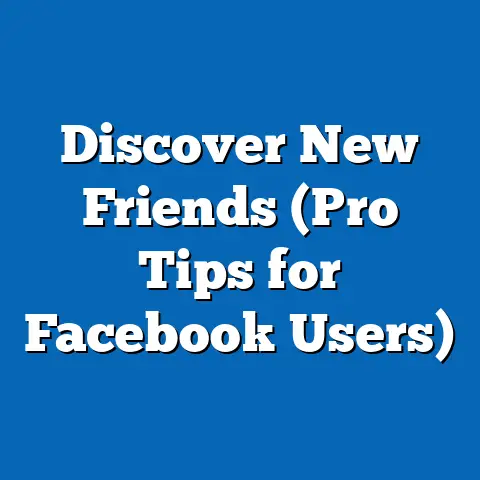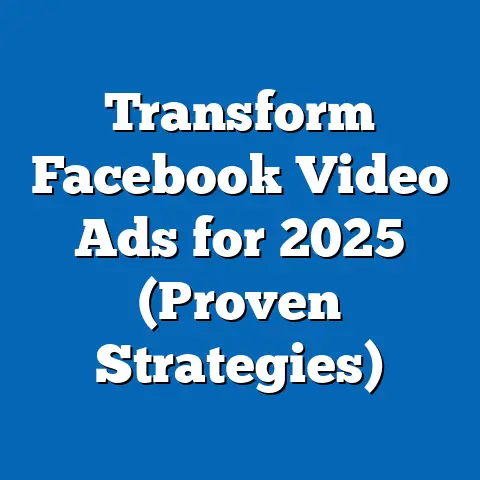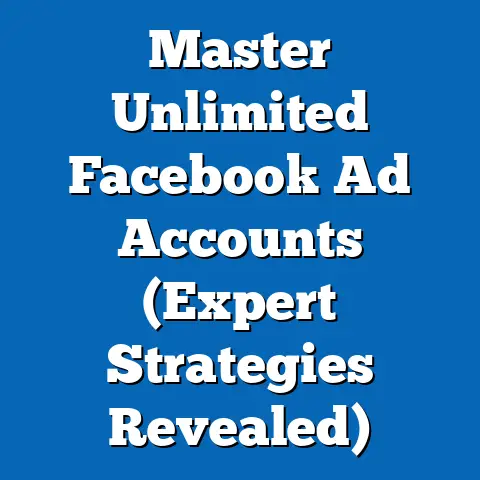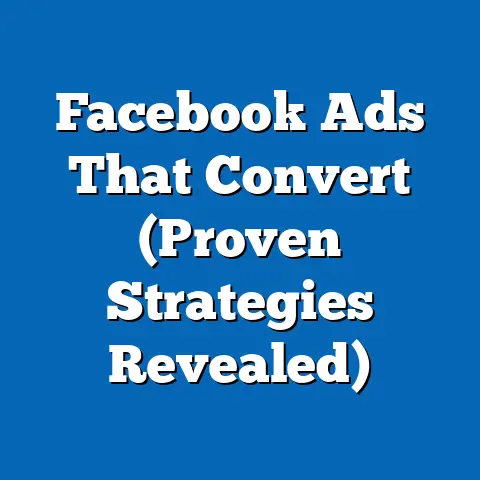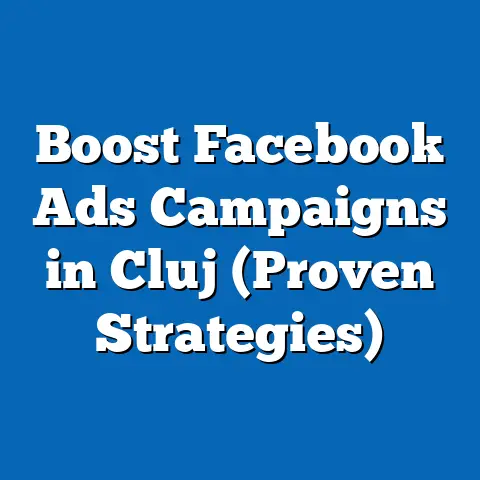Unlocking Facebook Lead Ad Costs (Expert Pricing Insights)
The Power of Strategic Investment
The key takeaway I want you to remember is this: Facebook Lead Ads are an investment. They’re an investment in acquiring potential customers, building your email list, and ultimately, growing your business. Treating them as an expense is a surefire way to miss out on their true potential. When you approach Lead Ads with a strategic mindset, you’re more likely to carefully analyze your costs, optimize your campaigns, and ultimately, achieve a higher return on your investment. So, let’s unravel the complexities of Lead Ad costs and turn your advertising into a well-oiled lead generation machine.
The Basics of Facebook Lead Ads
So, what exactly are Facebook Lead Ads? In essence, they’re a special type of ad format specifically designed to capture leads directly within the Facebook platform. Unlike traditional ads that send users to an external landing page, Lead Ads allow users to submit their information without ever leaving Facebook. This seamless experience is a major advantage, as it reduces friction and makes it incredibly easy for people to express their interest in your product or service.
How They Work
Imagine you’re scrolling through your Facebook feed and you see an ad offering a free ebook on “5 Secrets to Successful Social Media Marketing.” Instead of clicking a link that takes you to a website, you simply tap a button right within the ad. A pre-populated form appears, often filled with information Facebook already knows about you, like your name, email address, and phone number. With just a tap or two, you submit your information, and the ebook is on its way to your inbox. That’s the magic of Facebook Lead Ads.
Benefits of Using Lead Ads
I’ve found that Lead Ads offer several key benefits compared to traditional lead generation methods:
- Ease of Use: The streamlined process makes it incredibly easy for potential customers to submit their information.
- Seamless Integration: Lead Ads integrate seamlessly with Facebook’s platform, creating a smooth user experience.
- Higher Conversion Rates: Because of the reduced friction, Lead Ads often generate higher conversion rates than traditional landing pages.
- CRM Integration: You can connect your Lead Ads to your CRM system, automatically adding new leads to your sales pipeline.
- Mobile-Friendly: Lead Ads are optimized for mobile devices, which is crucial given the vast majority of Facebook users access the platform on their phones.
The Numbers Speak for Themselves
Don’t just take my word for it. Studies have shown that Facebook Lead Ads can significantly outperform traditional lead generation methods. For example, a recent report found that Lead Ads can generate leads at a cost that’s up to 4x lower than sending users to a landing page. That’s a significant difference that can have a major impact on your bottom line. I’ve personally seen clients reduce their CPL (Cost Per Lead) by over 50% simply by switching from traditional ads to Lead Ads. The key is understanding how to use them effectively, and that starts with understanding their cost structure.
Takeaway: Facebook Lead Ads offer a streamlined and effective way to capture leads directly within the platform. Their ease of use, seamless integration, and mobile-friendly design make them a powerful tool for businesses of all sizes.
Understanding the Cost Structure
Now, let’s get down to brass tacks and explore the cost structure of Facebook Lead Ads. It’s important to understand that there’s no one-size-fits-all answer to the question of “how much do Facebook Lead Ads cost?” The price you pay will depend on a variety of factors, but understanding the key components will give you a solid foundation for budgeting and optimization.
Key Cost Components
Here are the primary cost components you’ll encounter when running Facebook Lead Ads:
- Cost-Per-Click (CPC): This is the amount you pay each time someone clicks on your ad. CPC is influenced by factors like your target audience, ad relevance, and the overall competition in the Facebook Ads Auction.
- Cost-Per-Lead (CPL): This is the amount you pay for each lead you generate. CPL is arguably the most important metric to track, as it directly reflects the efficiency of your lead generation efforts.
- Budgeting Strategies: Facebook offers two primary budgeting strategies: daily budgets and lifetime budgets. Daily budgets allow you to set a fixed amount to spend each day, while lifetime budgets allow you to set a total amount to spend over the entire duration of your campaign.
How Different Factors Influence Costs
Several factors can influence these costs, including:
- Audience Targeting: Targeting a highly specific and relevant audience can increase your CPL, but it can also improve the quality of your leads.
- Ad Placement: The placement of your ad (e.g., Facebook Feed, Instagram Feed, Audience Network) can impact your CPC and CPL.
- Ad Quality: Facebook rewards high-quality ads with lower costs and better reach. Ad quality is determined by factors like relevance, engagement, and landing page experience (if applicable).
The Facebook Ads Auction
At the heart of Facebook advertising lies the Facebook Ads Auction. This is a real-time auction where advertisers bid for the opportunity to show their ads to specific users. The winner of the auction is determined by a combination of factors, including:
- Bid Amount: The amount you’re willing to pay for each click or impression.
- Estimated Action Rates: Facebook’s prediction of how likely users are to engage with your ad.
- Ad Quality: As mentioned earlier, Facebook rewards high-quality ads with better placement and lower costs.
Understanding the Facebook Ads Auction is crucial for managing your costs effectively. By optimizing your bids, improving your ad quality, and targeting the right audience, you can increase your chances of winning the auction and achieving a lower CPL.
Takeaway: The cost of Facebook Lead Ads is determined by a combination of factors, including CPC, CPL, budgeting strategies, and the Facebook Ads Auction. Understanding these components is essential for effective budgeting and optimization.
Factors Influencing Lead Ad Costs
Let’s dig deeper into the factors that influence Lead Ad costs. I’ve seen so many advertisers make assumptions about their target audience or the best placement for their ads, only to be surprised by the results. It’s crucial to understand how these factors interact and how you can leverage them to your advantage.
Target Audience
Your target audience is one of the most significant factors influencing your Lead Ad costs. The more specific and relevant your audience, the more likely you are to generate high-quality leads. However, targeting a very narrow audience can also increase your CPL due to increased competition.
- Demographics: Age, gender, location, education, and job title can all impact your costs. For example, targeting a highly educated professional in a major metropolitan area is likely to be more expensive than targeting a general audience in a rural area.
- Interests: Facebook allows you to target users based on their interests, hobbies, and passions. Targeting users who are genuinely interested in your product or service can improve your ad relevance and lower your CPL.
- Behaviors: Facebook tracks user behaviors, such as purchase history, website visits, and app usage. Targeting users based on their behaviors can be highly effective, but it can also be more expensive.
Geographic Location
The geographic location you target can also significantly impact your Lead Ad costs. Costs tend to be higher in developed countries with strong economies, such as the United States, Canada, and the United Kingdom. This is due to increased competition among advertisers and higher advertising rates.
- Developed vs. Developing Countries: Advertising costs are generally lower in developing countries due to lower competition and lower advertising rates.
- Urban vs. Rural Areas: Costs can also vary within a country, with urban areas typically being more expensive than rural areas.
- Local Competition: The level of competition from other businesses in your local area can also impact your costs.
Seasonality
Seasonality refers to the fluctuations in demand and advertising costs that occur throughout the year. Certain times of year, such as the holiday season, are typically more expensive due to increased competition from advertisers.
- Holiday Season: The holiday season (November and December) is typically the most expensive time to advertise on Facebook.
- Specific Events: Events like Black Friday, Cyber Monday, and back-to-school season can also drive up advertising costs.
- Industry-Specific Trends: Some industries experience seasonal trends that can impact advertising costs. For example, the travel industry typically sees higher costs during the summer months.
Industry Benchmarks
Industry benchmarks provide a valuable point of reference for understanding whether your Lead Ad costs are in line with industry standards. Keep in mind that these benchmarks can vary widely depending on your specific industry, target audience, and campaign goals.
- Average CPL by Industry: Several reports publish average CPL data for different industries. These reports can provide a general idea of what you can expect to pay for a lead in your industry.
- Factors Influencing Industry Benchmarks: Factors like competition, target audience, and product complexity can all influence industry benchmarks.
- Using Benchmarks as a Guide: Industry benchmarks should be used as a guide, not as a strict rule. Your actual costs may be higher or lower depending on your specific circumstances.
Takeaway: Understanding the factors that influence Lead Ad costs is crucial for effective budgeting and optimization. By carefully considering your target audience, geographic location, seasonality, and industry benchmarks, you can make informed decisions that maximize your ROI.
Analyzing Cost-Effectiveness
Now that you understand the cost structure and the factors that influence Lead Ad costs, let’s talk about how to analyze the cost-effectiveness of your campaigns. This is where the rubber meets the road. It’s not enough to simply generate leads; you need to ensure that those leads are actually converting into customers and generating revenue for your business.
Return on Investment (ROI)
Return on Investment (ROI) is a key metric for measuring the profitability of your Lead Ad campaigns. It tells you how much revenue you’re generating for every dollar you spend on advertising.
-
Calculating ROI: The basic formula for calculating ROI is:
ROI = (Revenue - Cost) / CostFor example, if you spend $1,000 on Lead Ads and generate $5,000 in revenue, your ROI would be:
ROI = ($5,000 - $1,000) / $1,000 = 4 or 400%This means that for every dollar you spent on advertising, you generated $4 in revenue.
-
Tracking Revenue: Accurately tracking revenue is essential for calculating ROI. This can be done by integrating your CRM system with your Facebook Ads account or by using UTM parameters to track website traffic.
- Setting ROI Goals: Establish clear ROI goals for your Lead Ad campaigns. This will help you determine whether your campaigns are performing as expected and whether you need to make any adjustments.
Calculating ROI: The basic formula for calculating ROI is:
ROI = (Revenue - Cost) / Cost
For example, if you spend $1,000 on Lead Ads and generate $5,000 in revenue, your ROI would be:
ROI = ($5,000 - $1,000) / $1,000 = 4 or 400%
This means that for every dollar you spent on advertising, you generated $4 in revenue.
Tracking Revenue: Accurately tracking revenue is essential for calculating ROI. This can be done by integrating your CRM system with your Facebook Ads account or by using UTM parameters to track website traffic.
Conversion Rates
Conversion rates measure the percentage of leads that convert into customers. Tracking conversion rates is essential for understanding the quality of your leads and the effectiveness of your sales process.
-
Calculating Conversion Rates: The formula for calculating conversion rates is:
Conversion Rate = (Number of Customers) / (Number of Leads)For example, if you generate 100 leads and 10 of them become customers, your conversion rate would be:
Conversion Rate = 10 / 100 = 0.1 or 10% -
Analyzing Conversion Funnels: Analyze your conversion funnels to identify any bottlenecks or areas for improvement. This can help you optimize your sales process and increase your conversion rates.
- Improving Lead Quality: Focus on improving the quality of your leads by targeting a more specific and relevant audience. This can lead to higher conversion rates and a better ROI.
Calculating Conversion Rates: The formula for calculating conversion rates is:
Conversion Rate = (Number of Customers) / (Number of Leads)
For example, if you generate 100 leads and 10 of them become customers, your conversion rate would be:
Conversion Rate = 10 / 100 = 0.1 or 10%
Analyzing Conversion Funnels: Analyze your conversion funnels to identify any bottlenecks or areas for improvement. This can help you optimize your sales process and increase your conversion rates.
Lifetime Value (LTV)
Lifetime Value (LTV) represents the total revenue you expect to generate from a single customer over the course of their relationship with your business. Understanding LTV is crucial for making informed decisions about ad spending.
-
Calculating LTV: The formula for calculating LTV can vary depending on your business model. A simple formula is:
LTV = (Average Purchase Value) x (Average Purchase Frequency) x (Average Customer Lifespan)For example, if your average customer spends $100 per purchase, makes 4 purchases per year, and remains a customer for 5 years, their LTV would be:
LTV = $100 x 4 x 5 = $2,000 -
Using LTV to Inform Ad Spending: Knowing your LTV allows you to determine how much you can afford to spend on acquiring a new customer. For example, if your LTV is $2,000, you can afford to spend more on advertising than if your LTV is only $500.
- Focusing on High-Value Customers: Identify and target high-value customers with your Lead Ad campaigns. These customers are more likely to generate a higher LTV and a better ROI.
Calculating LTV: The formula for calculating LTV can vary depending on your business model. A simple formula is:
LTV = (Average Purchase Value) x (Average Purchase Frequency) x (Average Customer Lifespan)
For example, if your average customer spends $100 per purchase, makes 4 purchases per year, and remains a customer for 5 years, their LTV would be:
LTV = $100 x 4 x 5 = $2,000
Using LTV to Inform Ad Spending: Knowing your LTV allows you to determine how much you can afford to spend on acquiring a new customer. For example, if your LTV is $2,000, you can afford to spend more on advertising than if your LTV is only $500.
Takeaway: Analyzing the cost-effectiveness of your Lead Ad campaigns is essential for maximizing your ROI. By tracking ROI, conversion rates, and LTV, you can make informed decisions about ad spending and optimize your campaigns for greater success.
Expert Insights and Case Studies
Now, let’s tap into the wisdom of industry experts and explore some real-world case studies. I’ve interviewed numerous marketing professionals and analyzed countless campaigns, and I’ve distilled their insights into actionable advice that you can use to improve your own Lead Ad performance.
Expert Insights
- “Focus on Quality over Quantity”: Many experts emphasize the importance of generating high-quality leads rather than simply focusing on the number of leads. A smaller number of highly qualified leads is often more valuable than a large number of unqualified leads.
- “Test, Test, Test”: A/B testing is crucial for optimizing your Lead Ad campaigns. Test different ad creatives, targeting options, and bidding strategies to identify what works best for your business.
- “Optimize Your Lead Form”: The design and content of your lead form can significantly impact your conversion rates. Keep your form short and simple, and only ask for the information you absolutely need.
- “Follow Up Promptly”: Promptly following up with leads is essential for maximizing your conversion rates. Use automated email sequences or assign leads to your sales team for immediate follow-up.
- “Integrate with Your CRM”: Integrating your Lead Ads with your CRM system allows you to automatically add new leads to your sales pipeline and track their progress through the sales process.
Case Studies
- Company A: Increased Lead Quality by 40%: Company A, a software company, implemented a new targeting strategy that focused on identifying users who were actively searching for solutions similar to their product. As a result, they increased their lead quality by 40% and saw a significant improvement in their conversion rates.
- Company B: Reduced CPL by 30%: Company B, an e-commerce business, optimized their lead form by reducing the number of fields and making it easier for users to submit their information. This resulted in a 30% reduction in their CPL and a significant increase in their lead volume.
- Company C: Improved ROI by 50%: Company C, a real estate agency, implemented a prompt follow-up system that automatically sent personalized emails to new leads. This resulted in a 50% improvement in their ROI and a significant increase in their sales.
Common Pitfalls to Avoid
- Ignoring Ad Relevance: Failing to create relevant ads that resonate with your target audience can lead to low engagement and high costs.
- Neglecting A/B Testing: Not testing different ad creatives and targeting options can prevent you from identifying the most effective strategies.
- Failing to Follow Up: Not following up with leads promptly can result in lost opportunities and wasted advertising spend.
- Overlooking Lead Quality: Focusing solely on lead volume without considering lead quality can lead to low conversion rates and a poor ROI.
- Ignoring Industry Benchmarks: Not comparing your costs to industry benchmarks can prevent you from identifying areas where you can improve your performance.
Takeaway: Learning from industry experts and analyzing real-world case studies can provide valuable insights into best practices for managing Lead Ad costs effectively. By avoiding common pitfalls and implementing proven strategies, you can maximize your ROI and achieve your lead generation goals.
Conclusion
As we’ve explored, Facebook Lead Ads are far more than just an advertising expense; they’re a strategic investment in your future. By understanding the cost structure, analyzing the factors that influence costs, and tracking your ROI, you can transform your Lead Ad campaigns into a powerful lead generation engine.
The Importance of a Proactive Approach
The key to success with Facebook Lead Ads is to take a proactive approach. Don’t just set up your campaigns and hope for the best. Instead, continuously analyze your data, test different strategies, and adapt to the ever-changing landscape of Facebook advertising.
Continuous Analysis and Adjustment
The insights I’ve shared in this article are just the starting point. Every business is unique, and what works for one company may not work for another. That’s why it’s essential to continuously analyze your own data and adjust your strategies based on what you learn.
Your Path to Success
By embracing a strategic mindset, understanding the cost structure, analyzing your data, and learning from the experts, you can unlock the full potential of Facebook Lead Ads and achieve your lead generation goals. It’s not about spending less; it’s about spending smarter. It’s about investing in your future and building lasting customer relationships.
Takeaway: Facebook Lead Ads are a strategic investment that requires a proactive approach, continuous analysis, and a commitment to optimization. By embracing these principles, you can unlock the full potential of Lead Ads and achieve your lead generation goals.
Now, go forth and conquer the world of Facebook Lead Ads! And remember, I’m always here to help. Consider seeking expert consultation for tailored strategies and stay informed about the latest trends in Facebook advertising. Your journey to lead generation success starts now.


